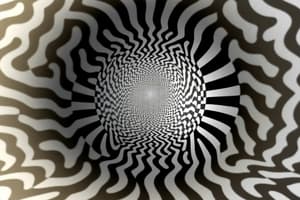Podcast
Questions and Answers
What are visual illusions?
What are visual illusions?
Visual illusions are distortions of perceptions of visual images.
What does the Müller-Lyer illusion consist of?
What does the Müller-Lyer illusion consist of?
Two lines of equal length with opposite-shaped patterns on the ends.
Which perspectives explain the Müller-Lyer illusion?
Which perspectives explain the Müller-Lyer illusion?
- Socio-cultural perspective (correct)
- Behavioural perspective (correct)
- Biological perspective (correct)
- Cognitive perspective (correct)
What does the biological perspective emphasize regarding the Müller-Lyer illusion?
What does the biological perspective emphasize regarding the Müller-Lyer illusion?
What does the behavioural perspective propose about the Müller-Lyer illusion?
What does the behavioural perspective propose about the Müller-Lyer illusion?
What is the focus of the socio-cultural perspective in relation to the Müller-Lyer illusion?
What is the focus of the socio-cultural perspective in relation to the Müller-Lyer illusion?
What is the cognitive perspective's explanation for the Müller-Lyer illusion?
What is the cognitive perspective's explanation for the Müller-Lyer illusion?
How does size constancy affect our perception of objects?
How does size constancy affect our perception of objects?
Describe the shape and characteristics of the Ames room.
Describe the shape and characteristics of the Ames room.
Flashcards
Visual Illusions
Visual Illusions
Distortions in the perception of visual images affecting judgments.
Müller-Lyer Illusion
Müller-Lyer Illusion
Two equal-length lines with opposite patterns appear different due to illusions.
Eye Movement Theory
Eye Movement Theory
Suggests eye movements influence perception of length in illusions.
Carpentered World Hypothesis
Carpentered World Hypothesis
Signup and view all the flashcards
Cognitive Perspective
Cognitive Perspective
Signup and view all the flashcards
Size Constancy
Size Constancy
Signup and view all the flashcards
Ames Room
Ames Room
Signup and view all the flashcards
Biological Perspective
Biological Perspective
Signup and view all the flashcards
Socio-Cultural Perspective
Socio-Cultural Perspective
Signup and view all the flashcards
Study Notes
Visual Illusions
- Visual illusions are distortions in the perception of visual images, affecting judgments on length, curvature, position, speed, or direction.
- The brain, not the eyes, is responsible for misleading interpretations of visual stimuli.
The Müller-Lyer Illusion
- The illusion comprises two equal-length lines, each with opposite-shaped patterns (arrowheads and feather tails).
- The feather-tailed line appears longer than the arrow-headed line despite being equal in length.
Explanations for the Müller-Lyer Illusion
- Since its description in 1889, four contemporary perspectives explain the perceived size difference:
- Biological
- Behavioural
- Socio-cultural
- Cognitive
Biological Perspective
- Focuses on the role of the eyes, nervous system, and brain in perceiving the illusion.
- The 'Eye Movement' theory suggests increased eye movement when viewing the feather-tailed line causes a perception of length. This theory is rejected, as the illusion persists even without eye movements.
Behavioural Perspective
- Emphasizes the influence of learning and past experience.
- The 'carpentered world' hypothesis relates the illusion to architectural elements familiar in urban environments, leading to misperceptions based on prior experiences with corners.
Socio-Cultural Perspective
- Examines how cultural and social factors impact perception of the illusion.
- Studies indicate that children from 'non-carpentered worlds' are less likely to perceive the Müller-Lyer illusion.
Cognitive Perspective
- Focuses on the mechanism of processing visual information and how it leads to the illusion.
- Misapplication of size constancy occurs, where lines are misperceived as different distances from the observer, influencing perceived size.
- Arrowheads are interpreted as closer (outer wall of a building), while feather tails are seen as further away (corner of a room).
Cognitive Perspective: Size Constancy
- Size constancy helps perceive objects consistently despite distance changes, recognizing tall individuals' height from various distances.
- Application of this principle to two-dimensional images can result in perceptual errors, with outside corners seen as nearby and inside corners perceived as distant.
Ames Room
- The Ames room creates a distorted shape, appearing trapezoidal rather than rectangular.
- It manipulates dimensions, making people appear larger or smaller based on their position relative to the distorted rear wall.
- Markings and structural distortions activate shape constancy mechanisms, leading to misperceptions.
Studying That Suits You
Use AI to generate personalized quizzes and flashcards to suit your learning preferences.




